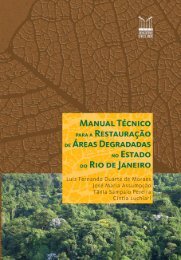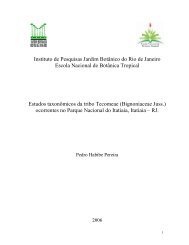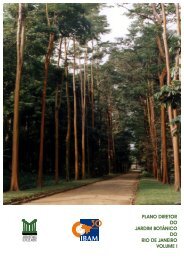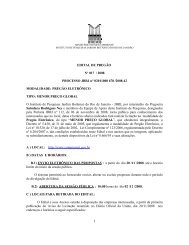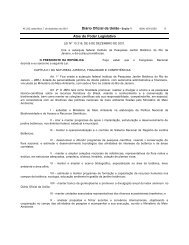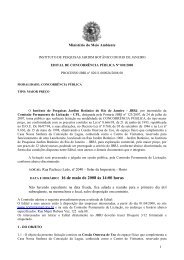anatomia do lenho e dendrocronologia de lianas da famÃlia ...
anatomia do lenho e dendrocronologia de lianas da famÃlia ...
anatomia do lenho e dendrocronologia de lianas da famÃlia ...
You also want an ePaper? Increase the reach of your titles
YUMPU automatically turns print PDFs into web optimized ePapers that Google loves.
44<br />
INTRODUCTION<br />
In tropical forests, <strong>lianas</strong> are important component playing an essential ecological role in<br />
many aspects. Over the past two <strong>de</strong>ca<strong>de</strong>s has been an increasing interest and awareness for<br />
this growth form, although it is still poorly un<strong>de</strong>rstood in many aspects (Gentry, 1991;<br />
Schnitzer & Bongers, 2002; Pérez-Salicrup, Schnitzer & Putz, 2004; Gerwing et al., 2006).<br />
Little attention has been spent on anatomy of <strong>lianas</strong> (Carlquist, 1985; Bamber & Ter Welle,<br />
1994) and almost none to growth rings in <strong>lianas</strong>, which few papers report this feature and it is<br />
not focused on researches (Baas & Schweingruber, 1987; Gasson & Dobbins, 1991; Carlquist,<br />
1995; Araque, De Pernía & León, 2000). Information about growth rings in trees is<br />
accessible, but from others growth forms is scarce. Schweingruber & Poschlod (2005) wi<strong>de</strong>ly<br />
studied growth rings in herbs and shrubs, and they report distinct growth rings on these other<br />
growth forms.<br />
In the last <strong>de</strong>ca<strong>de</strong>s, many <strong>de</strong>ndrochronologic studies in tropical tree species did report<br />
occurrence of seasonal growth rings, correlated with some climatic variations (Mariaux, 1981;<br />
Villalba, Boninsegna & Holmes, 1985; Détienne, 1989; Worbes, 1989, 1995; Buckley et al.,<br />
1995; Devall, Parresol & Wright, 1995; Gourlay, 1995a, 1995b; Heinrich & Banks, 2006;<br />
Westbrook, Guilserson & Colinvaux, 2006). In Brazil, some studies were <strong>de</strong>veloped in the<br />
Amazon forest (Botosso, 1984; Worbes, 1985; Vetter & Botosso, 1989) and in the Atlantic<br />
forest biomes (Seitz & Kanninen, 1989; Calla<strong>do</strong> et al., 2001a, 2001b, 2004; Marcati,<br />
Angyalossy & Evert, 2006). The overview of tree-ring research in tropics is given by Worbes<br />
(2002).<br />
Lianas are woody climbers which <strong>de</strong>velopment begins on the ground but their ability to selfsupport<br />
is lost with the growth; they need a support to ascend to canopy and they are able to<br />
grow in mature forests (Gentry, 1991; Gerwing et al., 2006). Most of <strong>lianas</strong> shows cambial<br />
variants and a few parts have stem anatomy similar of those observed on trees and shrubs, in<br />
which the cambium is single and cylindrical and produces internally secon<strong>da</strong>ry xylem and<br />
externally secon<strong>da</strong>ry phloem, with alike amount in all portions of stem (Carlquist, 1991,<br />
2001; Caballé, 1993). However, it follows anatomical ten<strong>de</strong>ncies correlated to habit, e.g.<br />
higher conductive area and low proportion of supporting tissues (Carlquist, 1991).<br />
Lianas are an important structural component of tropical forests and represent around of 25 %<br />
in abun<strong>da</strong>nce and species richness (Gentry, 1991; Schnitzer & Bongers, 2002; Pérez-Salicrup<br />
et al., 2004). Leguminosae is the third largest family of climbers in the New World and with<br />
Bignoniaceae they are <strong>do</strong>minant climbing families in neotropical lowland forests (Gentry,



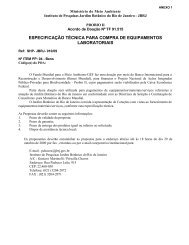

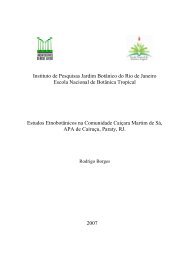
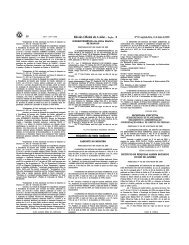
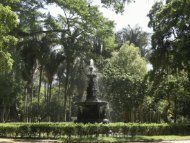
![Memorando nº [Número do memorando/DAMF-RJ/Nome da Unidade]](https://img.yumpu.com/43163661/1/184x260/memorando-na-namero-do-memorando-damf-rj-nome-da-unidade.jpg?quality=85)
